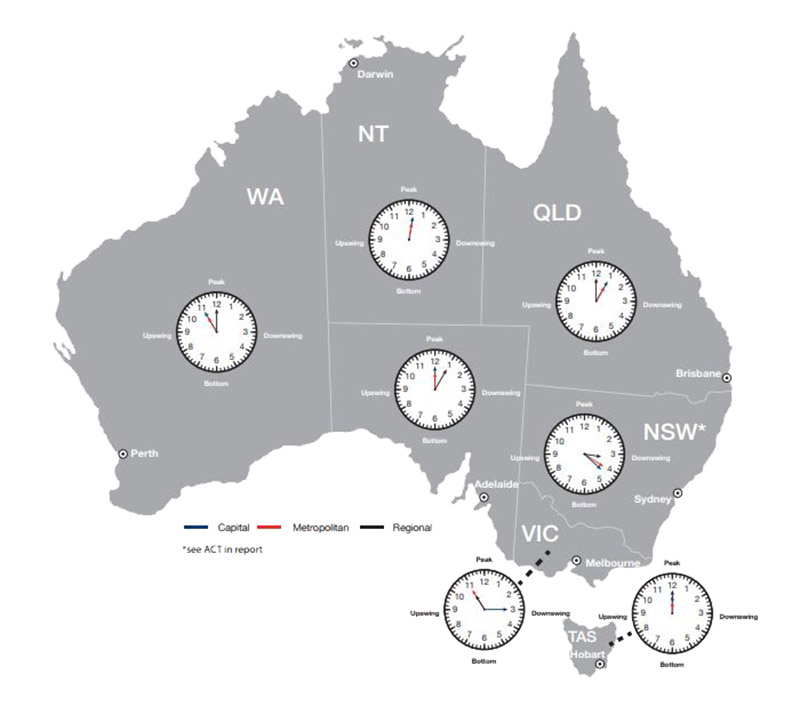20 suburbs identified as defying property price downturn
The property clock is ticking at different speeds for Australia's diverse real estate markets, but at least 20 suburbs are expected to provide timely investment returns in coming years.
Property investors are keenly seeking pockets of potential capital growth as prices fall across most capital cities.
New research commissioned by Well Money has identified metropolitan and regional locations where prices look set to rise rather than fall.
The spread across states and building types will likely attract the attention of investors, given the changing housing finance landscape.
Housing finance commitment was $32.4 billion in May 2022, almost on par with 12 months prior ($32.6 billion in May 2022).
The proportion of finance for owner-occupiers, however, has declined from 72% to 65%, while investors now account for 35 or new loans, up from 28 per cent over the last 12 months.
The quarterly Well Money Green Shoots Report identified the top 20 suburbs in Australia that are currently showing the clearest signs of upcoming strong price growth
The 20 suburbs were based on having the strongest combination of inventory levels decreasing over the past three months, days on market decreasing over the past three months and asking prices increasing over the past three months.
| Rank | State | Suburb | Postcode | Type | Median asking price |
|---|---|---|---|---|---|
| 1 | NSW | Seven Hills | 2147 | Unit | $640,0000 |
| 2 | WA | Scarborough | 6019 | House | $859,000 |
| 3 | QLD | Park Ridge | 4125 | House | $516,900 |
| 4 | WA | Tuart Hill | 6060 | House | $679,000 |
| 5 | NSW | Gosford | 2250 | Unit | $575,000 |
| 6 | NSW | Bermagui | 2546 | House | $929,200 |
| 7 | NSW | Carlingford | 2118 | Unit | $708,000 |
| 8 | QLD | Buddina | 4575 | Unit | $745,000 |
| 9 | VIC | Point Cook | 3030 | Unit | $550,000 |
| 10 | WA | Balcatta | 6021 | House | $660,950 |
| 11 | WA | Darling Downs | 6122 | House | $787,990 |
| 12 | QLD | Placid Hills | 4343 | House | $600,000 |
| 13 | WA | Margaret River | 6285 | House | $590,000 |
| 14 | NSW | Yass | 2582 | House | $761,540 |
| 15 | NSW | Googong | 2620 | House | $1,000,000 |
| 16 | WA | Cannington | 6107 | House | $454,258 |
| 17 | QLD | Labrador | 4215 | House | $645,201 |
| 18 | WA | Innaloo | 6018 | House | $640,000 |
| 19 | WA | Westminster | 6061 | House | $412,000 |
| 20 | WA | Rivervale | 6103 | House | $635,700 |
Consumer confidence has taken a 180-degree turn in the past 12 months, prompting investors to place more emphasis than ever on selecting the right location in which to invest.
The first six months in 2022 saw confidence fall below the 100 index point positive benchmark, at 88.4 index points.
Property clocks ticking
PRD Chief Economist, Dr Diaswati Mardiasmo said the property market is once again entering uncertain times.
“2022 brings new challenges to the property market, on top of issues faced in 2021,” she said.
“The Reserve Bank of Australia has changed its policy stance, while the Federal Government has not.
“As a result, each property market is reacting differently to the current forces at hand.
“Depending on demand and supply, the market can still be growing, holding steady, or turning to a decline”.

Well Money CEO Scott Spencer said of the housing markets that are bucking the downturn price trend that they all had inventory levels and days on market fall over the past three months, which means conditions have moved in favour of sellers.
“As a result, vendors have increased asking prices in all but two of the suburbs, despite the fact the market is cooling in many parts of the country.”

Scott Spencer, CEO, Well Money
Mr Spencer said when inventory levels are falling in a location, that’s a clear sign the pendulum is moving in the direction of vendors, because stock levels are declining.
“When days on market are falling, it suggests demand is increasing relative to supply.
“When inventory levels and days on market are both falling, it’s a clear sign that market forces are moving in favour of vendors – and the bigger the fall, the more likely that is to be true.”
Five of the eight capital cities recorded a month-on-month property price decline in July, led by Sydney and Melbourne where values fell 2.2% and 1.5% respectively. Brisbane also edged into negative growth territory for the first time since August 2020, with values down 0.8%, while Canberra (-1.1%) and Hobart (-1.5%) were also down over the month.
Perth (+0.2%), Adelaide (+0.4%) and Darwin (+0.5%) remained in positive growth through July, however most of these markets have recorded a sharp slowdown in the pace of capital gains since the first interest rate hike in May.




















